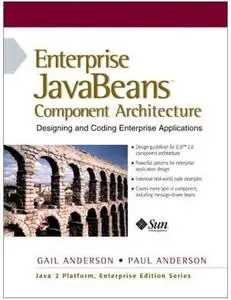Enterprise JavaBeans Component Architecture: Designing and Coding Enterprise Applications by Gail Anderson, Paul Anderson
Publisher: Prentice Hall PTR; 1st edition (March 11, 2002) | ISBN-10: 0130355712 | CHM | 2,4 Mb | 464 pages
Publisher: Prentice Hall PTR; 1st edition (March 11, 2002) | ISBN-10: 0130355712 | CHM | 2,4 Mb | 464 pages
— Design guidelines for EJB 2.0 component architecture — Powerful patterns for enterprise application design — Extensive real-world code examples — Covers every type of component, including message-driven beans
This book simplifies the creation of well-designed enterprise applications using the upgraded Enterprise JavaBeans 2.0 specification. Experienced Java platform mentors Gail Anderson and Paul Anderson use detailed code examples to introduce every key skill involved in creating components, stand-alone Java platform clients, and JavaServer Pages API clients. They introduce powerful EJB platform design patterns, and show how to apply them in real-world projects while avoiding critical errors in application design. Using actual business components, the authors show how to make the most of these key EJB component architecture features:
— Stateless and stateful session beans — Entity beans with bean-managed persistence — Entity beans with container-managed persistence — Container-managed relationships — Local and remote interfaces — The Enterprise JavaBeans Query Language — EJB 2.0 specification message driven beans
Each chapter includes a "Design Guidelines and Patterns" section designed to help you assess tradeoffs associated with your design decisions, and key point summaries that tie together important concepts. In short, Anderson and Anderson give you everything you need to build EJB 2.0 platform applications with maximum robustness, scalability, and performance.
Everything you need to take full advantage of the EJB 2.0 specification:
— Extensive code examples — real-world business components with just enough complexity to explain subtle design issues — How to apply J2EE platform design patterns — Value Object, Data Access Object, Value List Iterator, and Session Faade Pattern — Design guidelines for building distributed applications that avoid common pitfalls — Expert insight into matching enterprise beans to application requirements — Crystal-clear explanations of the key concepts that make EJB technology so powerful



